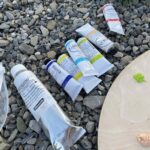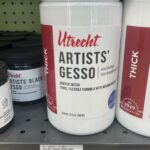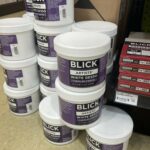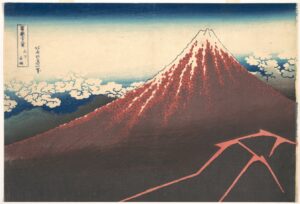Comprehensive Guide to Landscape Paintings
This is a comprehensive guide for anyone interested in creating a representational mountain landscape painting. Specifically, it is for painters who want to use oil paints and paint ‘from life.’

First, let’s get some basics out of the way.
Mountains are a classic motif for landscape painting. So, there are tons and tons of videos on Youtube showing you how to paint a mountain landscape. For example, there is this, this, and for those who want to paint in acrylics, this to watch.
If you’re reading this, I’m assuming you enjoy reading over watching me actually paint and talk at you.
If so, continue reading and I will bring down my process of painting from life into a step-by-step written guide.

Jean-Baptiste Camille Corot, Public domain, via Wikimedia Commons
Step-by-Step Guide: How to paint a mountain landscape
Starting a mountain landscape painting can be an exciting and creative process. Mountains are usually associated with grandeur and majesty. Their vast expanses evoke a sense of awe and wonder. A moving mountain landscape painting captures these elements of natural beauty. Due to this, many people want to paint mountains. A lot of people just wanat to paint from a picture. I am going to say something that will radically limit my blog readers, I guess, but here goes.
1. Gather reference material
Start by collecting reference material from other famous paintings of mountains. Take note of their differing approaches to the mountain. Be inspired! Notice their unique features, such as the shape, texture, and the various ways they are depicted. Reference material will provide you with valuable visual information as you begin your painting.
2. *Go to a mountain*
If you want to paint the mountain, you need to go to. the mountain.
That’s right. No painting from a photo. No painting from some zoomed-out Wikipedia public access image of a mountain. Find a real one. Now, I know what you might be thinking. How am I going to find a mountain? Well, it doesn’t have to be Mount Everest or a majestic Mount Fuji. But, have you ever heard that saying that it’s best to write about what you know? Well, it’s best to paint what you know. If you only have hills in your town, find a hill. Do you live in a flat desert? Paint the flat desert for now. Please. I guarantee you that actually going to the place will make a huge improvement in your painting.
Here are some steps to help you begin:
3. Plan your composition
Consider how you want to compose your painting. Think about the placement of the mountains within the frame. Move your easel around. I mean, that’s the whole point of a landscape painting. It’s your chance to check out the view.
Ask yourself if there are any specific elements you want to include. Identify the foreground and background. Ask yourself what the point of focus will be f your painting. How do you want the viewer’s eye to move across your painting?
*Painting tip*: thumbnails
Sketch some thumbnails in your sketchbook. Draw a bunch of squares or rectangles, roughly the ratio of your canvas. It doesn’t have to be perfect. Then, sketch out the landscape in front of you. This will allow you to experiment with different compositions by sketching thumbnail drawings or making quick value studies to help you find the most visually appealing arrangement.
4. Set up your easel
Next, you must set up your painting area. This can be really simple if you want. Of course, some people go all out. Personally, I just pop up an easel and, ideally, a little side table for my supplies. I keep a paper towel roll nearby at all times, too. You’ll need it!
Some people have fancy oil paint boxes to organize their paint. Usually, I just stick mine in a toiletry bag. Sometimes, I even throw them in a ziplock plastic bag. It really doesn’t matter. Ensure that you organize your paints so they are easily accessible to make the painting process smoother. If you are using oil paints, make sure you have your medium, turpentine, and cleaning agent (I suggest orange pumice hand soap) ready.

5. Block in the basic shapes
Now, you’re ready to get painting! Start by blocking in your basic shapes. At this point, you can take a few different routes. You can mix a lot of linseed oil and mineral spirits and make a light wash to block in your shapes. Personally, I just paint wet-on-wet and get right at it. I bang out those basic shapes right away. I don’t layer and finish it all in one go. If you like building up your canvass, though, you can start with a wash or even do an underpainting first.
Either way, what is important is to get the drawing, colors, and values right.
- Drawing: Capture the overall shape of the mountain. Pay attention to the angles,
- Values: Decide right now what the value of the foreground, middle ground, and background is.
- Color: Then, what are their colors? Which fields are muddier and which are richer in hue? Which are cooler or warmer? *Hint: the places closest to you will be higher saturated, and the ones further away are likely to be less so. Also, the foregrounds in the shadows will have the richest colors of all.
And, at this point, it is important to be decisive and *accurate*.
After a lot of practice, this is where you get to shine. That moment when you immediately mix up the color, use your biggest brush to smear it across your canvas, and it just sits precisely where it is supposed to sit. It’s like hitting a tennis ball on the sweet spot. A few accurate color/value choices at this stage will get you at 3/4 of the way to your finished piece at least. In fact, sometimes, if the foreground, middle ground, and background fields are sitting just right, you might decide to just stop right here.
6. Depict atmospheric perspective
Take a look at The 3 Essentials For Creating A Convincing Feeling of Depth And Mood In Your Landscape Paintings before beginning your mountain landscape painting. To employ atmospheric perspective, a painter typically employs the following principles:

- Value Gradation: Objects in the distance are painted with lighter values compared to those in the foreground. As objects recede, they appear less distinct due to the scattering of light in the atmosphere. This lightening of values helps create an illusion of depth.
- Color Shift: Colors in the distance tend to be cooler and less saturated. This is because the atmosphere scatters and absorbs warm colors, making them appear less vibrant. By adjusting the color temperature and saturation, a painter can convey a sense of depth and atmospheric haze.
- Detail and Clarity: Objects in the foreground are usually depicted with more precise and distinct details, while those in the background are depicted with less defined edges and softer focus. This mimics the way distant objects appear less sharply defined due to atmospheric interference.
By employing these techniques, a painter can effectively convey a sense of depth and distance.
*Painting tip* Know when to stop.
A wonderful former painting professor of mine, Joan Curran, once told. The most important part of being a painter is knowing when to stop painting. If you have a held-together painting and it’s interesting enough, in your opinion, just…stop. That’s it.
However, if you want to keep going, this is the point where you step back. I mean, really back.
Squint. Does anything seem fundamentally off? This is the point where you can adjust your values. If nothing is majorly off, then you are ready for the next step. The next step is to be more specific.
7. Finishing touches (specificity)
Lastly, you can be more specific, now. This means addressing detail and edges.
Observe more closely now. Make sure you can identify the light source of your painting. If it creates areas of light and shadow, then make sure you depictured those accurately. They will give dimension and depth to the mountains.
Then, pay attention to edge relationships. The edges of the landscape are not uniform. Some will be hard. Some will be soft and fuzzy. Use a variety of brushstrokes and different brushes to depict these different edges. Some might melt into one another. If you want, you can also use this technique to depict different textures, such as rocky surfaces, vegetation, or snow.
But, don’t make it too fussy! Step away from your painting often.
A good rule of thumb an amazing painting instructor taught me is to look at the landscape 80% of the time, and your painting only 20%. You should certainly be looking at the landscape more than your canvas- I mean, I lot more.
Pay attention to any patterns you see: do you want to exaggerate them? How does the landscape feel?
*Painting tip* for painting from life
To really get into the habit of doing this, I even suggest doing painting exercises where you set up your canvas and the colors accurately on your palette, and then you paint without *ever* looking at your own painting. Do it! You will be amazed at the outcome.
A lot of beginner paintings try to capture every single detail in their painting. Don’t do this. You are not God/omnipotent. You’re not a scanner; you’re an artist! And, anyway, that’s not how the human eye works. We don’t ‘see’ every detail in front of us all at once. Some things are in focus. Others aren’t.
So, I suggest you begin by sticking to a simple formula. Later, you can develop it further. But, for now, choose one or two things you want to keep in focus and add detail there. Leave the rest.
Remember, starting a landscape painting is just the beginning. You can refine and develop your work as you progress. Experiment, explore different techniques, and trust your artistic instincts. You will be creating unique, beautiful depictions of the mountains in no time.
Choices: thinking through painting
Many people hold this deeply flawed belief that painting from life is somehow conceptually vacuous. As if there is no underlying theory or interesting aspect of painting the world as it is. In reality (see what I did there?) to quote Mark Twain, “‘Truth is stranger than fiction, but it is because Fiction is obliged to stick to possibilities; Truth isn’t.”
Just because you are painting what you see, doesn’t mean you are an empty copying machine. You can’t act as a neutral vessel or tool to print out a copy of the world in front of you. That’s actually impossible. Every choice in how you depict ‘reality’ is full of you. You make choices that decide what reality is. There is no objective reality.
Symbolism and Metaphor
With this in mind, here are some underlying symbols and metaphors to consider for each choice you make. Think of them while going through your thumbnail sketches and choosing your composition, going through your brushes and choosing your brush strokes, or going through your viewpoint and choosing a focal point.
Strength and stability
Mountains have symbolic significance in many cultures. They can represent strength, stability, and endurance. Mountain landscapes can also evoke a sense of journey or ascent, symbolizing personal growth, overcoming challenges, and reaching new heights. People may resonate with these symbolic meanings. If these interest you, make choices that strengthen these associations.
Tranquility and escape
Mountains are often perceived as serene and peaceful environments. They can offer a sense of escape, and a mountain landscape painting provides a means for individuals to immerse themselves in a tranquil scene, creating a temporary escape and a moment of serenity.

Albert Bierstadt, Public domain, via Wikimedia Commons
Who are some famous historical landscape painters who painted mountains?
There have been many famous historical landscape painters who depicted mountains in their works. Here are a few notable examples:
Caspar David Friedrich (1774-1840):
Friedrich was a German Romantic painter who create contemplative and atmospheric landscapes. His works often featured mountains as powerful symbols of spirituality and the sublime. One of his most famous mountain paintings is “Wanderer above the Sea of Fog.”
Albert Bierstadt (1830-1902):
Bierstadt was an American artist who painted grandiose landscapes, particularly of the American West. He painted several majestic mountain scenes, including “The Rocky Mountains, Lander’s Peak” and “Among the Sierra Nevada Mountains, California.”
Thomas Moran (1837-1926):
Moran was an American painter and printmaker associated with the Hudson River School. He traveled extensively in the American West and produced stunning landscape paintings featuring mountains. His notable works include “Grand Canyon of the Yellowstone” and “Mount Moran.”
J.M.W. Turner (1775-1851):
Turner, an English painter, is one of the greatest landscape painters in Western art history. While he painted a wide range of subjects, mountains featured prominently in his works. His mountain landscapes often showcased dramatic lighting and atmospheric effects, such as in “Snow Storm: Hannibal and his Army Crossing the Alps.”
Frederic Edwin Church (1826-1900):
Church was an American landscape painter associated with the Hudson River School. He explored various locations, including the Andes Mountains in South America, and painted monumental landscapes with meticulous attention to detail. Notable mountain paintings by Church include “The Heart of the Andes” and “Cotopaxi.”
Jean-Baptiste Camille Corot (1796-1875):
Corot was a renowned French landscape painter and printmaker. He was one of the leading figures in the Barbizon School, a group of artists who revolutionized landscape painting in the mid-19th century. Corot’s work demonstrated a delicate and poetic interpretation of nature, capturing the subtle nuances of light, atmosphere, and mood. His paintings often featured tranquil landscapes, serene forests, and picturesque rural scenes, imbuing them with a sense of harmony and tranquility. Corot’s unique style combined elements of classical tradition with a more naturalistic approach, showcasing his keen observation of the natural world.
These are just a few examples of historical landscape painters known for their mountain paintings. Their works have had a significant influence on the genre. They also continue to inspire artists and art enthusiasts today.
Who are some contemporary landscape painters of mountains?
There are several contemporary landscape painters who specialize in painting mountains. Here are a few notable examples:
- Zaria Forman: Forman is an American artist known for her large-scale pastel drawings of landscapes, particularly icy and mountainous regions. Her hyperrealistic and detailed artworks capture the beauty and fragility of remote landscapes. She has created notable mountain pieces inspired by visiting places like Greenland and Antarctica.
- Conrad Jon Godly: Godly is a Swiss painter known for his large-scale, abstracted mountain landscapes. His works often emphasize the powerful and imposing nature of mountains, using bold brushstrokes and vibrant colors to create a sense of drama and awe.
- Peter Doig: Doig is a Scottish-born artist who painted dreamlike and atmospheric landscapes. While his works encompass a wide range of subjects, he has painted mountain scenes in a distinctive style. His paintings often have a sense of mystery and explore the psychological and emotional aspects of landscapes.
- Karen Hollingsworth: Hollingsworth is an American artist whose paintings primarily focus on capturing serene and contemplative natural landscapes, including mountain scenes. Her works often feature soft, muted colors and a sense of stillness, evoking a peaceful and reflective mood.
- Kim Cogan: Cogan is an American painter who explores urban and natural landscapes in his works. He has created beautiful mountain paintings that capture the interplay of light and shadow, as well as the textures and details of rocky formations.
These contemporary landscape painters bring their own unique styles and perspectives to the portrayal of mountains. Through their art, they continue to celebrate the beauty and significance of mountains in the modern world.
How can I sell my landscape paintings?
Selling your mountain landscape painting can be exciting. It is a way to share your art with others and potentially earn income, too. Here are the steps to start selling your work. First, you build your portfolio. Then, you research the market. Next, you establish an online presence. Then, you utilize art platforms and/or approach galleries to sell your work.
I go into these in more detail below.
Build a portfolio
Create a strong portfolio of your landscape paintings. When I was younger (I am middle-aged now), we had physical portfolios. (Remember those?) Now, digital portfolios suffice. Select your best and most representative works that showcase your skills and style. Ensure that your portfolio is well-organized and presented professionally, either physically or through a digital portfolio on a website or social media platform.
Research the market
Familiarize yourself with the art market, particularly the market for landscape paintings. Explore galleries, online art platforms, local art fairs, and exhibitions to understand potential buyers’ trends, pricing, and preferences. This research will help you determine the best avenues for selling your paintings.
Establish your online presence
In today’s digital age, having an online presence is crucial for reaching a wider audience. Create a website or set up accounts on social media platforms dedicated to showcasing your artwork. Your website doesn’t need to be extremely interactive or in-depth. For the first decade after my MFA, I used a simple Indexhibit site. Regularly update your online platforms with high-quality images of your paintings, descriptions, and relevant information about yourself as an artist. I suggest sending out a yearly newsletter to update everyone on your studio practice, too.
Utilize online art platforms
Consider joining online art marketplaces and platforms that cater to artists looking to sell their work. Platforms like Etsy, Saatchi Art, and Artfinder allow artists to list and sell their paintings directly to buyers worldwide. These platforms provide exposure to a large audience and handle payment transactions on your behalf.
Approach galleries and art exhibitions
Research local galleries and art spaces that exhibit landscape paintings. Submit your portfolio and inquire about opportunities to exhibit or sell your work through their gallery. Participating in art exhibitions and group shows can help raise your visibility as an artist and connect you with potential buyers.
Network and collaborate
Engage with fellow artists, art enthusiasts, and potential buyers by attending art events, workshops, and community gatherings. Networking can lead to collaborations, commissions, and referrals. Building relationships within the art community can open doors to new selling opportunities.
Pricing and marketing
Determine the pricing of your landscape paintings based on factors such as size, medium, complexity, and experience level. Research the market value of similar works and seek advice from fellow artists or art professionals. Develop a marketing strategy that includes compelling descriptions, storytelling, and captivating images of your paintings to attract potential buyers.
Consignment and commissions
Explore the option of consigning your mountain landscape painting to local art galleries, boutique shops, or other businesses interested in displaying and selling your work on your behalf. Additionally, consider accepting commissions for custom landscape paintings based on clients’ specific preferences and locations.
Remember that selling artwork takes time and persistence. It’s essential to continuously refine your skills, promote your work, and actively seek out opportunities. Building a strong artistic brand, nurturing relationships, and adapting to the evolving art market will contribute to your success as a landscape artist.
People’s affinity for mountain landscape paintings can be attributed to a combination of their natural beauty, the sense of tranquility they evoke, their symbolic meanings, the connection to nature they provide, and their aesthetic appeal.
More
- Mixing It Up: House paint and oil paint?
- To Gesso or Not to Gesso? Exploring House Paint in Your Art
- What is the best way to apply gesso to canvas?
- All About Black Gesso
- Gesso Substitutes in a Pinch
- Brushing Up on Oil Painting: Essential Toolkit







